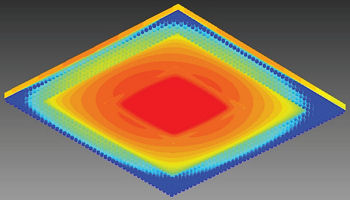10 Tips for Predicting Component Temperatures … A High-Level “How To” Guide
April 11, 2014
 Dear Desktop Engineering Reader:
Dear Desktop Engineering Reader:
David Letterman, the host of CBS’s “Late Show,” announced his retirement plans the other day. You can say a lot either way about Letterman, but he deserves credit for single-handedly dragging the concept of a “top 10 list” out of the AM radio swamp and into the everyday argot of Americans. Top 10 lists are used everywhere from a jape to rib the birthday boy to a friendly format to convey serious stuff. That friendly format to convey serious stuff is what we have at the other side of today’s Check it Out link.
“10 Tips for Predicting Component Temperatures … A High-Level ‘How To’ Guide” from Mentor Graphics really is something of a top 10 list of the key considerations to keep in mind when designing and analyzing components for such electronic assemblies as chip packages and printed circuit boards (PCBs). There’s no tomfoolery here, and this white paper makes no attempt to be a meticulous tome presenting every detail that someone might deem key to component temperature prediction. That would be an impossible task. Still, this nine-page PDF proves itself to be a thorough and highly useful conductor of good practices in electronic component analyses as well as a handy set of reminders to keep you focused when things get hot.
 Written in a conversational tone that assumes a familiarity with electronic component thermal design analysis, the goal of this paper is to help you have greater confidence in your simulation results. The pathway to that end is to show you how you can obtain high-fidelity predictions of the temperature of your components across the design flow starting at a point before you’ve routed a board or determined the number of board layers right on through to final simulation results. Here’s a quick look at a couple of this paper’s highlights.
Written in a conversational tone that assumes a familiarity with electronic component thermal design analysis, the goal of this paper is to help you have greater confidence in your simulation results. The pathway to that end is to show you how you can obtain high-fidelity predictions of the temperature of your components across the design flow starting at a point before you’ve routed a board or determined the number of board layers right on through to final simulation results. Here’s a quick look at a couple of this paper’s highlights.
It all begins with a look at the components you should model explicitly as part of your thermal simulation. Key components are a given as are larger components, say electrolytic capacitors, that can mess up your airflow. But many small components might not be thermally sensitive because of low-power density, so there’s no need to model these discretely as 3D objects. You could, for example, apply the heat effects from these components as a background heat source across the entire board.
From there, the paper moves to some explicit recommendations, such as use good power estimates, before going into its longest discussion. This discussion, called “Use Compact Thermal Models from Early Design,” delves into 2-Resistor and DELPHI compact thermal models as well as RC-Ladder models and detailed models. Each model is defined in terms of where it is best deployed and why you would want to use it. For example, DELPHI models are described as adequate for detailed thermal design work except for the most thermally critical packages. Detailed models, on the other hand, can provide the highest fidelity, assuming you have your geometry and material properties together.
Additional topics include using power maps, custom heatsink design, validating detailed models, accurately capturing thermal interface material resistance and predicting mechanical stress. Six illustrations are offered, including a couple of neat screen shots.
Whether the goal of your thermal design analysis efforts is to increase component reliability or improve performance, or if you want to avoid systematic problems during operation, “10 Tips for Predicting Component Temperatures … A High-Level ‘How To’ Guide” has something for you. In the course of the paper, applications from Mentor Graphics—including FloTHERM, FloTHERM PCB, Modelsim, and T3Ster—are mentioned in context of a discussion, but this is not a product datasheet by any stretch of the imagination. Instead what you’ll find are a lot of tips and tricks as well as a wealth of common sense throughout that can help you reach your goals.
Thanks, Pal. – Lockwood
Anthony J. Lockwood
Editor at Large, Desktop Engineering
Go here to download “10 Tips for Predicting Component Temperatures … A High-Level ‘How To’ Guide.”
Subscribe to our FREE magazine, FREE email newsletters or both!
About the Author
Anthony J. Lockwood is Digital Engineering’s founding editor. He is now retired. Contact him via [email protected].
Follow DE





